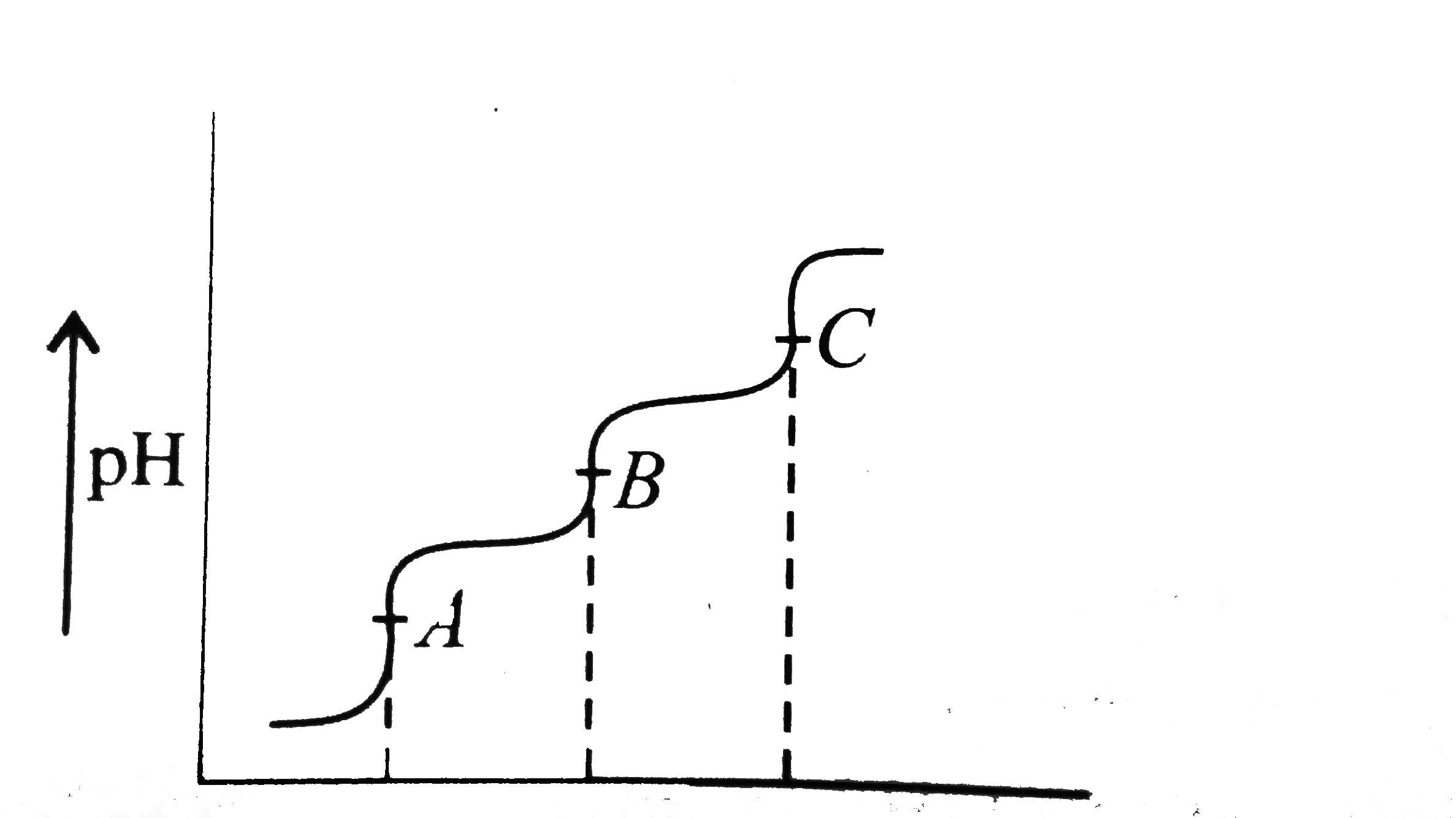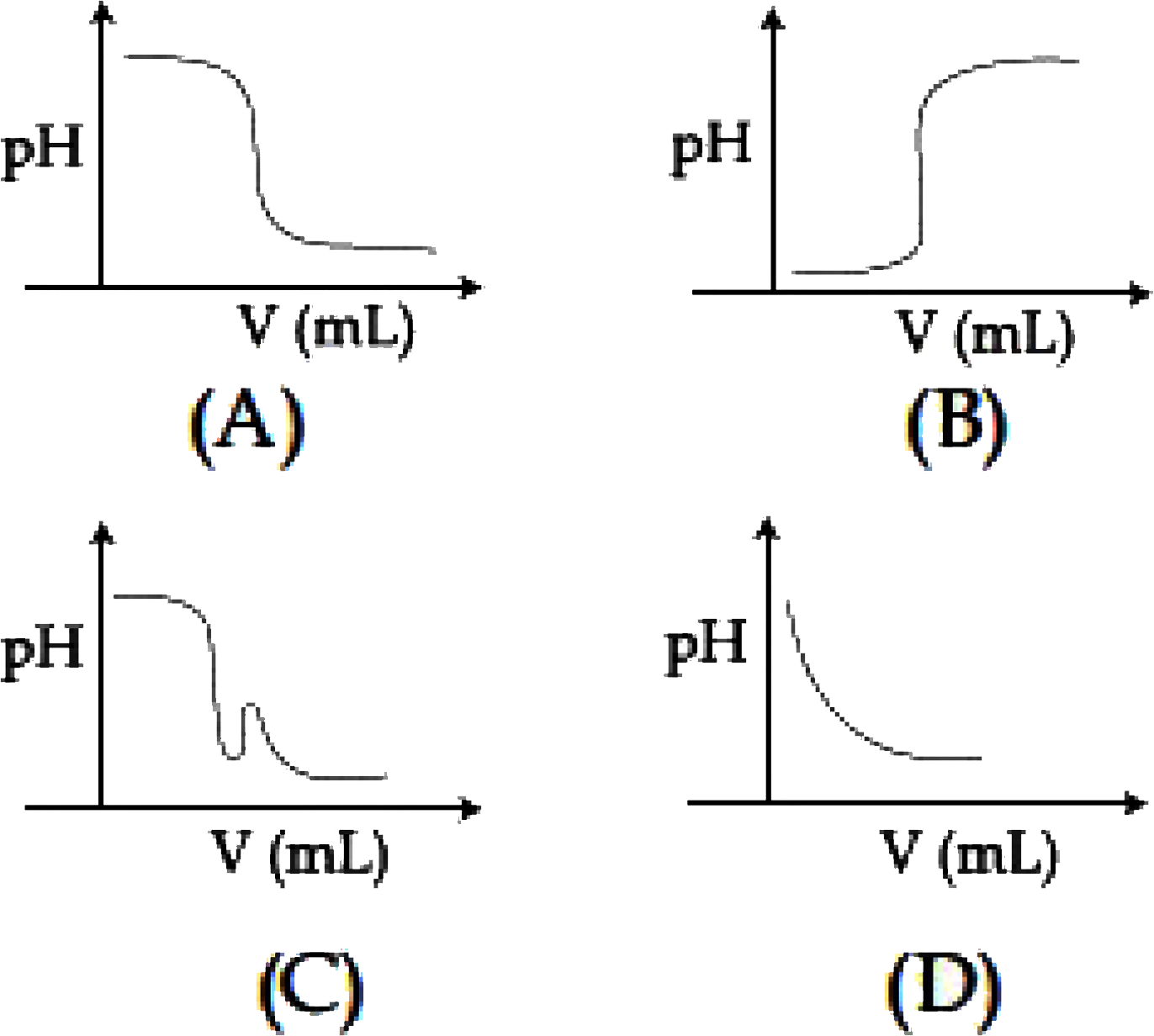Acidic solution is defined as a solution whose [H⊕]>[ΘOH]. Base solution has [ΘOH]>[H⊕]. During acid-base titrations, pH of the mixture will change depending on the amount base added. This variation is shown in the form of graph by making plot as titration curves 100mL of 1.0MH3A(Ka1=10−3,Ka2=10−5,Ka3=10−7) is titrated against 0.1MNaOh. The titration curve is as follows.
![Acidic solution is defined as a solution whose [H^(o+)] gt [overset(Theta)OH]. Base solution has [overset(Theta)OH] gt [H^(o+)]. During acid-base titrations, pH of the mixture will change depending on the amount base added. This variation is shown in the form of graph by making plot as titration curves 100mL of 1.0 M H(3)A (K(a(1)) = 10^(-3), K(a(2)) = 10^(-5), K(a(3)) = 10^(-7)) is titrated against 0.1M NaOh. The titration curve is as follows. What will be the change in pH from point B to point C?](https://d10lpgp6xz60nq.cloudfront.net/physics_images/V_PHY_CHM_P1_C08_E01_178_Q01.png)
What will be the change in pH from point B to point C?
2.8
3.2
4.6
0.94
The correct Answer is:D
At point B,Na2HA is formed, hydrolysis of HA2− is considered and hydrolysis of NaH2Ais supressed (Ka2 is considered) due to common ion [ΘOH] effect.
HA2−+H2O⇔H2AΘ+ΘOH
H2AΘ+H2O⇔H3A+ΘOH
At point B, salt Na2HA (salt of WA/SB) is formed. So the volume of NaOH used at point B is 2 times the volume of H3A used.
Total volume of solution
=(100mL+200mL)=300mL
M1V1(Beoe)=M2V2(After)
0.1×100=M2×300
M2=0.13=130=0.033
∴[Na2HA]=0.033M
∴pH=12(pKw+pKa3+logC)
=12(14+5+log130)=12(19−1.48)=8.76
change is pH=9.7−8.76=0.94
Topper's Solved these Questions
- IONIC EQUILIBRIUMBOOK - CENGAGE CHEMISTRY ENGLISHCHAPTER - IONIC EQUILIBRIUMEXERCISE - Exercises Multiple Correct
33 Videos
- IONIC EQUILIBRIUMBOOK - CENGAGE CHEMISTRY ENGLISHCHAPTER - IONIC EQUILIBRIUMEXERCISE - Exercises Single Correct
121 Videos
- IONIC EQUILIBRIUMBOOK - CENGAGE CHEMISTRY ENGLISHCHAPTER - IONIC EQUILIBRIUMEXERCISE - Exercises Subjective(Coordination Equilibria)
2 Videos
- HYDROGEN, WATER AND HYDROGEN PEROXIDEBOOK - CENGAGE CHEMISTRY ENGLISHCHAPTER - HYDROGEN, WATER AND HYDROGEN PEROXIDEEXERCISE - Subjective Archive (Subjective)
3 Videos
- ISOMERISMBOOK - CENGAGE CHEMISTRY ENGLISHCHAPTER - ISOMERISMEXERCISE - Assertion-Reasoning Type
1 Videos
Similar Questions
Acidic solution is defined as a solution whose [H⊕]>[ΘOH]. Base solution has [ΘOH]>[H⊕]. During acid-base titrations, pH of the mixture will change depending on the amount base added. This variation is shown in the form of graph by making plot as titration curves 100mL of 1.0MH3A(Ka1=10−3,Ka2=10−5,Ka3=10−7) is titrated against 0.1MNaOh. The titration curve is as follows.

What is the pH at point A?
View SolutionIn a solution of 0.1MH3PO4 acid (Given Ka1=10−3,Ka2=10−7,Ka3=10−12)
pH of solution is
View SolutionIn a solution of 0.1MH3PO4 acid (Given Ka1=10−3,Ka2=10−7,Ka3=10−12)
Concentration of H2PO−4 is
View SolutionIn a solution of 0.1MH3PO4 acid Given Ka1=10−3,Ka2=10−7,Ka3=10−12)
Concentration of HPO2−4 is
View SolutionRatio of [HA+] in 1L of 0.1MH3A solution [Ka1=10−5,Ka2=10−8Ka3=10−11]& upon addition of 0.1mole HCl to it will be :
View SolutionCalculate the changes in pH of 0.1MNaHA solution after diluting it to ten times the original volume.(Given that for H3A:Ka1=10−4,Ka2=10−7,Ka3=10−11)
View SolutionHin is an acidic indicator (KInd=10−7) which dissociates into aqueous acidic solution of 30mL of 0.05MH3PO4(K1=10−3,K2=10−7,K3=10−13)
Calculate the [IndΘH∈]
View SolutionIn 0.1M HCl solution, 0.1M NaOH solution is added gradually then identify the correct graph in this titration
View SolutionWhat is the pHof 0.01MH2S solution ? Also determine [HS−] & [S2−] Given: For H2S,Ka1=9×10−8,Ka2=1.2×10−13
View SolutionIn acid-base titration, 0.1MHCl solution was added to the NaOH solution of unknown strength. Which of the following correctly shown the change of pH of the titration mixture in this experiment?

View Solution
